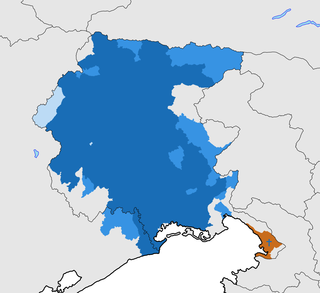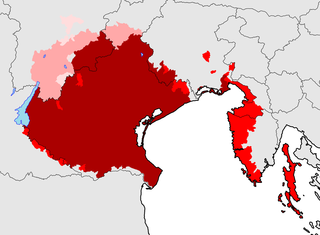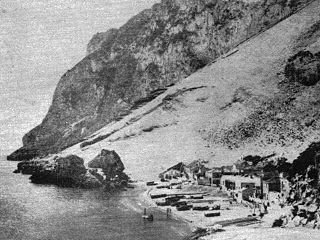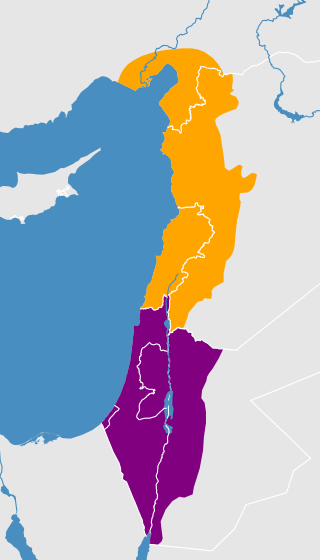Related Research Articles
The Hebrew alphabet, known variously by scholars as the Ktav Ashuri, Jewish script, square script and block script, is traditionally an abjad script used in the writing of the Hebrew language and other Jewish languages, most notably Yiddish, Ladino, Judeo-Arabic, and Judeo-Persian. In modern Hebrew, vowels are increasingly introduced. It is also used informally in Israel to write Levantine Arabic, especially among Druze. It is an offshoot of the Imperial Aramaic alphabet, which flourished during the Achaemenid Empire and which itself derives from the Phoenician alphabet.
Modern Hebrew has 25 to 27 consonants and 5 to 10 vowels, depending on the speaker and the analysis.

The Romaniote Jews or the Romaniotes are a Greek-speaking ethnic Jewish community native to the Eastern Mediterranean. They are one of the oldest Jewish communities in existence and the oldest Jewish community in Europe. The Romaniotes have been, and remain, historically distinct from the Sephardim, some of whom settled in Ottoman Greece after the expulsion of Jews from Spain and Portugal after 1492.
Non-native pronunciations of English result from the common linguistic phenomenon in which non-native speakers of any language tend to transfer the intonation, phonological processes and pronunciation rules of their first language into their English speech. They may also create innovative pronunciations not found in the speaker's native language.
In sociolinguistics, hypercorrection is nonstandard use of language that results from the overapplication of a perceived rule of language-usage prescription. A speaker or writer who produces a hypercorrection generally believes through a misunderstanding of such rules that the form or phrase they use is more "correct", standard, or otherwise preferable, often combined with a desire to appear formal or educated.

Friulian or Friulan is a Romance language belonging to the Rhaeto-Romance family, spoken in the Friuli region of northeastern Italy. Friulian has around 600,000 speakers, the vast majority of whom also speak Italian. It is sometimes called Eastern Ladin since it shares the same roots as Ladin, but over the centuries, it has diverged under the influence of surrounding languages, including German, Italian, Venetian, and Slovene. Documents in Friulian are attested from the 11th century and poetry and literature date as far back as 1300. By the 20th century, there was a revival of interest in the language.

Venetian, wider Venetian or Venetan is a Romance language spoken natively in the northeast of Italy, mostly in Veneto, where most of the five million inhabitants can understand it. It is sometimes spoken and often well understood outside Veneto: in Trentino, Friuli, the Julian March, Istria, and some towns of Slovenia, Dalmatia (Croatia) and Bay of Kotor (Montenegro) by a surviving autochthonous Venetian population, and in Argentina, Australia, Brazil, Canada, Mexico, the United States and the United Kingdom by Venetians in the diaspora.

Guttural R is the phenomenon whereby a rhotic consonant is produced in the back of the vocal tract rather than in the front portion thereof and thus as a guttural consonant. Speakers of languages with guttural R typically regard guttural and coronal rhotics to be alternative pronunciations of the same phoneme, despite articulatory differences. Similar consonants are found in other parts of the world, but they often have little to no cultural association or interchangeability with coronal rhotics and are (perhaps) not rhotics at all.
Judeo-Italian is an endangered Jewish language, with only about 200 speakers in Italy and 250 total speakers today. The language is one of the Italian languages and one of the Jewish Romance Languages. Some words have Italian prefixes and suffixes added to Hebrew words as well as Aramaic, roots. All of the language's dialects except one are now extinct.
Ashkenazi Hebrew is the pronunciation system for Biblical and Mishnaic Hebrew favored for Jewish liturgical use and Torah study by Ashkenazi Jewish practice.
Sephardi Hebrew is the pronunciation system for Biblical Hebrew favored for liturgical use by Sephardi Jews. Its phonology was influenced by contact languages such as Spanish and Portuguese, Judaeo-Spanish (Ladino), Judeo-Arabic dialects, and Modern Greek.
Mizrahi Hebrew, or Eastern Hebrew, refers to any of the pronunciation systems for Biblical Hebrew used liturgically by Mizrahi Jews: Jews from Arab countries or east of them and with a background of Arabic, Persian or other languages of Asia. As such, Mizrahi Hebrew is actually a blanket term for many dialects.

Neapolitan is a Romance language of the Italo-Romance group spoken in Naples and most of continental Southern Italy. It is named after the Kingdom of Naples, which once covered most of the area, since the city of Naples was its capital. On 14 October 2008, a law by the Region of Campania stated that Neapolitan was to be protected.
Regional Italian is any regional variety of the Italian language.

Judeo-Tat or Juhuri is a traditional language of the Mountain Jews, primarily spoken in Azerbaijan, Dagestan, and Israel.
In an alphabetic writing system, a silent letter is a letter that, in a particular word, does not correspond to any sound in the word's pronunciation. In linguistics, a silent letter is often symbolised with a null sign U+2205∅EMPTY SET. Null is an unpronounced or unwritten segment. The symbol resembles the Scandinavian letter Ø and other symbols.

Syrian Jews are Jews who lived in the region of the modern state of Syria, and their descendants born outside Syria. Syrian Jews derive their origin from two groups: from the Jews who inhabited the region of today's Syria from ancient times, and sometimes classified as Mizrahi Jews. Mizrahi is a generic term for the Jews with an extended history in Western Asia or North Africa); and from the Sephardi Jews who fled to Syria after the Alhambra Decree forced the expulsion of the Jews from Spain in 1492.
Judaeo-Piedmontese was the vernacular language of the Italian Jews living in Piedmont, Italy, from about the 15th century until World War II. It was based on the Piedmontese language, with many loanwords from ancient Hebrew, Provençal, and Spanish. Most of the speakers were murdered during the war, and as of 2015 it is virtually extinct.

Genoese Gibraltarians have existed in Gibraltar since the 16th century and later became an important part of the population. It is an ethnic community made up of descendants of Genoese and Ligurians who emigrated to Gibraltar during the Italian diaspora. The population of Gibraltar with Genoese surnames is around 20% of the total.

Palestinian Arabic is a dialect continuum of mutually intelligible varieties of Levantine Arabic spoken by most Palestinians in Palestine, Israel and in the Palestinian diaspora.
References
- ↑ Elia S. Artom, "La pronuncia dell'ebraico presso gli Ebrei di Italia", in Scritti in memoria di F. Luzzatto, Rassegna Mensile di Israel 28 (1962): 26-30.